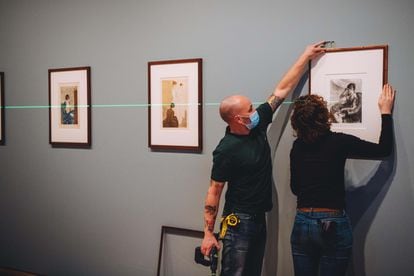Mary Cassatt, Berthe Morisot, and Marie Bracquemond are three female Impressionist painters who worked in Paris in the 19th century at the same time as their famous male colleagues. Grouped around the name of
The Three Great Ladies of Impressionism
, they form a league of artists whose talent managed to overcome the barrier of art understood, in their case, as a decorative pastime. Originally from the United States, Cassatt (1844-1926) was also the introducer of the pictorial movement in her native country. After a decade of searching, the Van Gogh Museum in Amsterdam has acquired three of his color prints and a black and white lithograph. A dream come true for the Dutch art gallery, which has one of the world's best collections of
Fin de Siècle prints
.
Together with the Rijksmuseum, they are the only two rooms that have works by Impressionist painters in the Netherlands.
More information
Mary Cassatt, the forgotten impressionist
Mary Cassatt was born in Pittsburgh, Pennsylvania, into an upper-middle-class family.
There was no other American artist in the Impressionist circle.
His biography indicates that his ancestors were Huguenots, the French Protestants of Calvinist doctrine, and that his original surname was Cossart.
After studying art in her country and in Europe, she ended up settling in Paris around 1875. Ahead of her time in the use of color in engraving, in 1879 she put all her efforts into a technique that was difficult to master but with which she achieved remarkable effects. admired by his colleagues Edgar Degas and Camille Pisarro.
The painter Mary Cassatt, in 1914. Archives of American Art, Smithsonian Institution
Dated between 1890 and 1891, the three prints bought by Van Gogh portray two intimate moments: a young woman washing herself in front of the mirror, another standing while the seamstress fixes the bottom of a dress, and another closing a letter. "Like several of her contemporaries, Van Gogh among them, Cassatt was inspired by the series of Japanese prints exhibited in Paris in 1890. The Dutch painter absorbs colors strongly, and she applies them with such mastery that it resembles a painting," he says. , in a telephone conversation, Fleur Roos Rosa de Carvalho, senior curator of the museum. In his opinion, the quality of the complex metal plate technique used and the subtlety with which he treats his motifs "add value to works of great quality and very difficult to find." “We would have bought them the same if they were from male impressionists,but we are delighted to increase our collection of prints made by women artists”, he says.
The lithograph features a young woman with binoculars in a theater box. The set has cost almost 1.5 million euros, financed with private funds destined for culture. It is a social scene, while other of the women Cassatt shows are in a homey and collected environment. It is what was called “the silent ritual of everyday life, with a spiritual and meditative tone at the same time, which we also find in the works of Vermeer”, continues the curator. "Cassatt achieved, especially in his paintings, an intimate look that today we would call organic." It refers to the canvases where the artist presents mothers with their children with the sensitivity and strength of the maternal bond. “In a way, she is the painter of motherhood, although she decided not to marry or start a family to maintain her independence.”In the letters addressed to his brother Theo, Vincent Van Gogh spoke of "two good painters who are worthwhile, and at that time he could only refer to Cassatt and Berthe Morisot, who were the most recognized", he adds. It is unclear if Theo, an art dealer, sold any of these works.
“feminine charm”
Various workers at the Van Gogh Museum place Cassatt's pieces.
Cassatt maintained a close professional relationship with the painter Edgar Degas, who invited her to present her paintings with the group of Impressionists. For her part, Berthe Morisot, married to Eugène Manet, the brother of the painter Édouard Manet, was the only woman who participated in the first Impressionist exhibition. He had previously exhibited at the appreciated, as well as feared, Salon de Paris. Sponsored by the French Government and with an academic jury, it was the annual exhibition of the Academy of Fine Arts. Cassatt, who also presented her works there, was very critical of the criteria of the judges, who often rejected the artists if they did not have a patron or a protector. Morisot became famous, but despite her success critics often praised her "elegance and feminine charm". Some adjectives that were not awarded to their male colleagues.
In 1971, the American historian Linda Nochlin published an essay that addresses this phenomenon and is considered the founding text of feminist art theory. Entitled
Why haven't there been great female artists?, it
points out: “There is no innate female style. Women artists or writers are closer to other creators of their time than to each other”. It does not seem to him that issues such as motherhood or parenting can be equated to a style, "because they were also addressed by men like Monet or Renoir, recognized impressionists" without receiving those names.
According to Fleur Roos Rosa de Carvalho, the price paid for Cassatt's prints and lithographs shows the high value attributed today to the works of these artists.
"It is true that their success cannot yet be compared to that of their colleagues, although they did value them at the time without making any distinction other than the quality of their works," he says.
Marie Bracquemond is an example of the importance of this support, also in her private life.
He caught the attention of Degas with his designs for decorating porcelain and exhibited in three Impressionist shows.
Her husband, Felix Bracquemond, was a successful painter highly critical of Impressionism.
Despite his wife's worth, he so discouraged her in public that she practically stopped painting around 1890.

